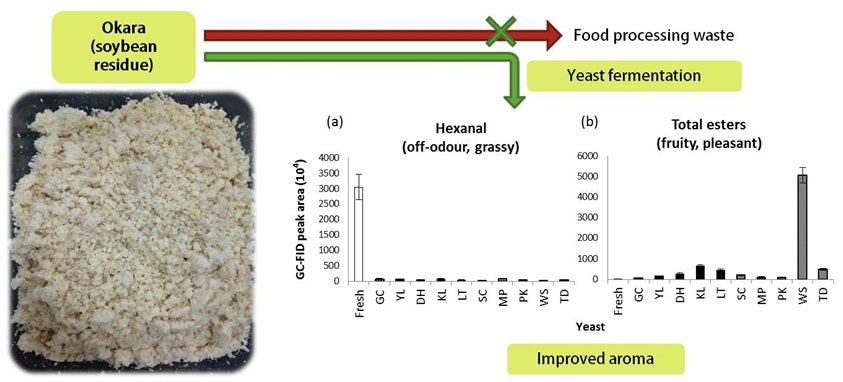Yeast-fermented okara: Smells good!
LIU Shao-Quan (Group Leader, Chemistry) () May 13, 201613 May 2016 NUS food scientists explore and expand the potential use of soybean residue (okara), a food processing waste, by yeast fermentation.
Okara is the soybean residue that remains after soymilk manufacture. Highly perishable and with an undesirable grassy off-odour, okara is often disposed of by food producers, resulting in opportunity cost and food processing waste. To overcome this problem, a team led by Prof LIU Shao-Quan from NUS’ Food Science and Technology (FST) Programme investigated the aroma profiles of okara fermented by 10 individual yeasts that are normally used to make cheese and wine. Yeast fermentation significantly decreased key off-odourants in okara by biotransforming them into methyl ketones and/or esters. Notably, okara fermented by Williopsis saturnus smelled pleasantly fruity and contained the greatest amount and variety of esters. Yeast fermentation can thus reduce food waste and add value to okara.
In Singapore, about 10,000 tonnes of okara are produced annually, and they are normally disposed of at a cost to food companies. Okara has limited use as a direct food ingredient as it is not easily digested, has anti-nutritive factors, and an unpleasant smell and texture. The improved aroma of yeast-fermented okara can potentially widen and diversify the application of okara as a functional food ingredient or as an inexpensive material for flavour extraction.
Further work on this preliminary study includes exploring various conditions and treatments to increase the yield of desirable aroma compounds, especially C6 fruity esters, in yeast-fermented okara. The team will also investigate if other non-volatile flavours and health-promoting substances are generated during okara fermentation. Positive results will strengthen the value proposition of yeast-fermented okara as a more palatable and healthful ingredient.
Currently, studies have shown that fermentation increases the health benefits of okara, but almost none of them considered the aroma aspect, and only a few studies look into yeast-fermented okara. By exploring these two uncharted areas, Prof Liu hopes that his work on yeast-fermented okara not only fills existing research gaps, but also stimulates the creation of fermented products from soybean processing waste with health benefits and enhanced flavour.
Prof Liu has attended a conference in Switzerland (on food waste valorization: Technical & Legal Challenges, 9-10-11 March 2016, Vevey/Montreux, and Switzerland). The link shows a Swiss TV report on the event in French: http://www.rts.ch/play/tv/19h30/video/la-communaute-scientifique-travaille-sur-la-revalorisation-des-dechets-alimentaires?id=7617625

Figure shows changes in (a) hexanal and (b) total esters in fresh okara (fresh) and yeast-fermented okara (GC = G. candidum, YL = Y. lipolytica, DH = D. hansenii, KL = K. lactis, LT = L. thermotolerans, SC = S. cerevisiae, MP = M. pulcherrima, PK = P. kluyveri, WS = W. saturnus, TD = T. delbrueckii.) [Image credit: VONG Weng Chan]
Reference
Vong WC, Liu SQ. “Changes in volatile profile of soybean residue (okara) upon solid-state fermentation by yeasts”. Journal of the Science of Food and Agriculture (2016) DOI: 10.1002/jsfa.7700.


